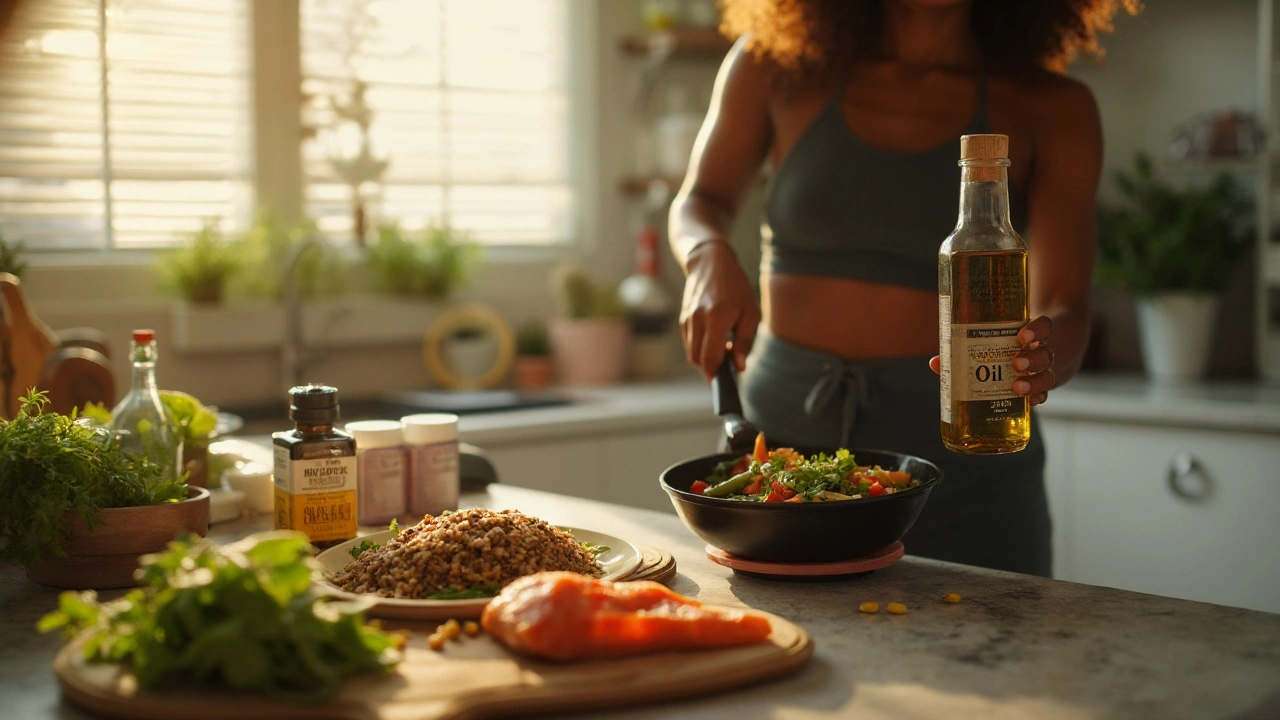Gamma Oryzanol Benefits and Uses: Heart Health, Menopause Relief, Dosage, Safety
 Sep, 2 2025
Sep, 2 2025
You clicked because you want real answers, not hype. Here’s the deal: gamma oryzanol is a natural compound from rice bran oil that gets marketed like a miracle. It does have meaningful benefits-especially for cholesterol and oxidative stress-but not every claim holds up. If you’re after better lipids, a steadier midlife transition, and a smarter oil for the pan, this will help you decide if it’s worth a spot in your routine.
- TL;DR
- Best supported benefit: modest LDL cholesterol reduction when rice bran oil replaces less healthy fats; typical change sits in the single-digit to low-teens percent over 4-8 weeks in small controlled trials.
- Menopause symptoms: older Japanese studies suggested fewer hot flashes; newer data is mixed and smaller. Consider it a maybe, not a sure thing.
- Antioxidant and gut protection: strong lab/animal support; human data is promising but not definitive.
- Not a testosterone booster or muscle-builder, despite gym lore.
- Safe for most adults at 100-300 mg/day as a supplement or 1-2 Tbsp/day rice bran oil; avoid if pregnant, breastfeeding, or on warfarin without medical guidance.
What you’re likely trying to get done
- Understand what gamma oryzanol is and which benefits are proven vs. hype.
- Decide if it fits your goal (cholesterol, menopause symptoms, gut comfort, antioxidant support).
- Choose between food (rice bran oil) and capsules, and dial in a realistic dose.
- Use it safely alongside meds like statins, diabetes drugs, or hormone therapy.
- Track what matters (lipids, symptoms, side effects) and know when to stop or switch.
What It Is, How It Works, and What It Can (and Can’t) Do
Gamma oryzanol is a mix of ferulic acid esters bound to plant sterols and triterpene alcohols naturally present in rice bran oil. Translation: it’s part antioxidant, part plant-sterol cousin. You’ll see it listed as oryzanol on some Asian cosmetic labels and as a dietary supplement in the West. In food, rice bran oil is the main source-neutral taste, high smoke point, and a decent amount of vitamin E family compounds.
Why it might help
- Lipids: Oryzanol and plant sterols reduce intestinal cholesterol absorption and promote bile acid excretion. The net effect is a nudge down in LDL and non-HDL cholesterol when it replaces saturated or refined oils.
- Oxidative stress: The ferulic acid backbone is a solid free-radical scavenger. In cells and animal models, oryzanol blunts lipid peroxidation and quiets inflammatory signaling.
- Gut lining support: Animal studies show protection against aspirin- and ethanol-induced gastric damage, likely via antioxidant and mucus-preserving effects.
- Neuroendocrine tuning: Early Japanese work proposed small effects on the autonomic nervous system, which is why it was tried for hot flashes. Modern human data is mixed.
What the evidence says, benefit by benefit
- Heart and cholesterol: Multiple small, controlled human trials substituting rice bran oil for other cooking fats reported LDL reductions in the ~7-15% range over 4-8 weeks, with favorable shifts in total cholesterol and ApoB. The effect comes from the combo of oryzanol, plant sterols, and vitamin E compounds, so you can’t credit oryzanol alone-but it’s part of the package. These are food swaps, not add-ons, which matters.
- Menopause symptoms (hot flashes, mood): Older Japanese clinic studies (using 300 mg/day) suggested fewer hot flashes and better mood scores. More recent small randomized trials haven’t consistently beaten placebo. If you want a non-hormonal try, it’s reasonable for 4-6 weeks, but expectations should be tempered. First-line options for bothersome symptoms still include evidence-based hormone therapy or certain non-hormonal meds; talk with your clinician.
- Glucose and metabolic markers: In people with type 2 diabetes, swapping in rice bran oil (sometimes blended with other oils) has modestly improved fasting glucose and HbA1c in short studies. Since the intervention was an oil swap, not a pure oryzanol supplement, the effect reflects the whole oil matrix and dietary context.
- Blood pressure: Small human studies show tiny reductions (think single digits) when rice bran oil replaces higher-saturated-fat oils. Don’t expect medication-level changes.
- Gut comfort and gastric protection: Stronger in animal data than human trials. If NSAIDs bother your stomach, switching to a gentler oil and eating more fiber is proven; oryzanol may add a bit of buffering, but it’s not a shield.
- Exercise performance and hormones: Despite decades of bodybuilding chatter, controlled trials in trained men found no boost in testosterone, strength, or mass versus placebo. Save your supplement budget here.
- Skin and UV: Ferulic acid (a component) stabilizes vitamins C and E in topical serums. Cosmetic chemists also use oryzanol as a UV-absorbing additive in some regions. As a dietary supplement, it’s not a sunscreen; still use SPF.
Safety snapshot
- Common doses: 100-300 mg/day for supplements; 1-2 Tbsp/day rice bran oil as a food swap.
- Typical side effects: mild GI upset, soft stools, rare itching.
- Avoid or get medical advice: pregnancy, breastfeeding, active anticoagulation (warfarin), and if you have a rice allergy (rare).
- Drug interactions: rice bran oil contains some vitamin K, which can affect warfarin; oryzanol itself doesn’t have a known direct anticoagulant effect. If you’re on statins, the LDL-lowering effects are additive, not duplicative-tell your clinician so they can watch your lipid panel.
Credibility check: the lipid improvements come from randomized substitutions of rice bran oil in everyday cooking, not miracle capsules. Hot-flash data is older and inconsistent. Most antioxidant claims are lab and animal-heavy. If you want a simple, real-world move with decent upside, using rice bran oil in the kitchen is the play.

How to Use It (Food vs. Capsule), Dosage, and Safe Setup
Before you buy a bottle, pick a lane. What’s your main goal? LDL down? A gentler midlife transition? A stomach that forgives NSAIDs a bit more? Goals drive dosage, form, and how you’ll judge success.
Step-by-step plan
- Pick your primary outcome. For heart health, focus on food swaps. For menopause symptoms, consider a short supplement trial. For general antioxidant support, either route works, but food-first keeps it simple.
- Choose your form.
- Rice bran oil (RBO): Use 1-2 tablespoons per day in place of your current cooking oil. It’s neutral, with a smoke point around 450°F/232°C. That’s enough to deliver an estimated 150-400 mg oryzanol daily depending on brand and processing.
- Capsules: 100-300 mg/day, usually split with meals. Choose third-party tested products when you can find them.
- Dial in the dose.
- Cholesterol focus: Prioritize 1-2 Tbsp/day RBO as a swap for butter, ghee, palm, or refined seed oils. Keep it up for 8-12 weeks, then recheck lipids.
- Menopause symptoms: 300 mg/day of a standardized capsule for 4-6 weeks. Track hot flashes, sleep, and mood. If nothing changes by week 6, shelve it.
- Gut comfort: Start with 1 Tbsp/day food swap. Notice how your stomach feels with coffee/NSAIDs; give it a couple weeks.
- Cook smart. RBO handles stir-fries and roasting. I like it for weeknight sheet-pan veggies-less smoke, clean taste. When my kid Lowell asked why the “oil bottle changed,” I told him I wanted crispy potatoes without a side of LDL.
- Track two things. (1) The outcome you care about (lipids, symptom diary, BP). (2) Any side effects (bloating, itch). Simple notes beat guesswork.
- Review at 8-12 weeks. Keep it if it’s working and easy. If not, pivot-there’s no prize for sticking with a dud.
Buyer’s notes
- Oil labels rarely list oryzanol content. As a rough guide, many RBOs carry ~1-2% oryzanol by weight. A tablespoon (~14 g) might give 140-280 mg.
- Refined vs. cold-pressed: Refining can trim minor components; oryzanol usually survives fairly well, but numbers vary. Choose reputable brands that share lab data if possible.
- Supplements: Look for standardized oryzanol content and third-party testing (NSF, USP, Informed Choice) when available. Avoid proprietary blends that hide dose.
Safety and interactions
- Warfarin: Because rice bran oil contains vitamin K, keep your anticoagulation team in the loop. Expect an INR check after diet shifts.
- Statins and ezetimibe: Food-based LDL drops are compatible and sometimes additive. Bring your lipid panel results to your next visit.
- Diabetes meds: Any change that improves diet quality can alter glucose needs. Watch for hypoglycemia if you’re tightly controlled.
- Pregnancy/breastfeeding: Skip oryzanol supplements for now-data is thin. Using RBO modestly in cooking is generally fine as part of a normal diet; discuss specifics with your clinician.
Pitfalls to avoid
- Adding oryzanol on top of a saturated-fat-heavy diet and expecting miracles. Swap, don’t stack.
- Expecting hot-flash relief in days. Give it 4-6 weeks, and don’t suffer needlessly-discuss proven options if symptoms are intense.
- Chasing testosterone or muscle gains. That claim hasn’t held up under controlled testing.
- Assuming any plant oil equals heart health. The whole diet pattern still rules.
Rules of thumb
- If LDL is your main target, measure before and 8-12 weeks after the swap. Aim for non-HDL cholesterol under 130 mg/dL (or as your clinician advises).
- If symptoms guide you (hot flashes, sleep), use a simple 0-10 daily rating. A 30% drop is a meaningful change.
- Keep total added oils to ~1-3 Tbsp/day. More oil isn’t more benefit.

Examples, Quick Reference, Checklist, and FAQs
Two real-world examples
- Heart-health swap: You switch from butter and palm oil to RBO for cooking and olive oil for salads. You keep fiber up (oats, beans), and walk 30 minutes most days. After 10 weeks, LDL drops from 150 to 132 mg/dL. Not a medical miracle-a smart nudge.
- Menopause trial: You run 300 mg/day oryzanol for 6 weeks. Hot flashes go from 7 to 5 per day, sleep improves slightly. You decide to keep the oil swap and discuss non-hormonal meds with your clinician for bigger relief.
Quick-start checklist
- Goal picked and written down
- Form chosen: RBO, capsules, or both
- Dose set: 1-2 Tbsp/day RBO or 300 mg/day capsules
- Tracking method: lipid panel dates or symptom diary
- Safety box checked: meds reviewed, pregnancy/breastfeeding screened
- 8-12 week review date on calendar
Food vs. supplement at a glance
| Source/Form | Typical Serving | Estimated Oryzanol (mg) | Best-Supported Outcome | Notes |
|---|---|---|---|---|
| Rice bran oil (cooking) | 1 Tbsp (~14 g) | ~140-280 | LDL reduction when replacing less healthy fats | High smoke point (~450°F); neutral flavor; contains vitamin E compounds |
| Rice bran oil (cooking) | 2 Tbsp (~28 g) | ~280-560 | Greater chance of lipid change; watch calories | Use for roasting, stir-fries, or sautéing |
| Gamma oryzanol capsule | 100 mg | 100 | Adjunct antioxidant support | Split with meals for tolerance |
| Gamma oryzanol capsule | 300 mg | 300 | Menopause symptom trial dose (mixed evidence) | Reassess at week 6 |
Pro tips
- Pair the oil swap with 5-10 g/day of soluble fiber (oats, psyllium, beans) for an extra LDL nudge.
- Use RBO for high heat and extra-virgin olive oil for salads. You get stability plus polyphenols.
- If you’re on warfarin, keep your vitamin K intake steady day to day; don’t yo-yo the oil amount.
Mini‑FAQ
- Is gamma oryzanol the same as ferulic acid? Not exactly. It’s ferulic acid bound to plant sterols/triterpene alcohols. In the body, both the ester and ferulic components may act.
- How long until I see changes? Lipids: 8-12 weeks after a steady oil swap. Menopause symptoms: if it helps, you’ll usually feel it in 2-6 weeks.
- Can I cook at high heat with rice bran oil? Yes. The smoke point is about 450°F/232°C.
- Will it raise testosterone or muscle mass? No. Controlled trials don’t show anabolic effects.
- Can it replace my statin? No. It’s a dietary assist, not a drug substitute. If you get great results, your clinician can decide on adjustments.
- Is it vegan and gluten-free? Yes, rice-derived and naturally gluten-free.
- Safe for kids? There’s no solid reason to supplement oryzanol in children. Using rice bran oil in family cooking is fine as part of a normal diet.
- Any allergy risks? Rice allergy is uncommon but possible. If you’ve reacted to rice-based products, skip it.
Next steps and troubleshooting
- If your LDL didn’t budge after 12 weeks: Confirm you truly swapped oils (and cut saturated fats), add 5-10 g/day soluble fiber, check steps per day, and verify your dose. If you’re already on a statin, ask your clinician about adding ezetimibe-it pairs well with dietary sterols.
- If hot flashes didn’t improve by week 6: Stop the supplement. Discuss evidence-based non-hormonal options (like SSRIs/SNRIs, gabapentin) or hormone therapy suitability.
- If you noticed GI upset: Drop to 1 Tbsp/day oil or 100 mg/day capsules, take with meals, and build back slowly if symptoms fade.
- If you’re on warfarin and your INR shifted: Keep your daily oil use consistent and loop in your care team for a dose tweak.
- If weight crept up: Remember oil is calorie-dense. Cap total added oils at 1-3 Tbsp/day and choose higher-volume, lower-cal foods (vegetables, legumes).
No single oil fixes a rough diet, but gamma oryzanol baked into everyday cooking is a low-friction move with a real chance to help your numbers-and it won’t make dinner taste like a science experiment. Start small, measure what matters, and keep what works.
shawn monroe
September 7, 2025 AT 20:07Gamma oryzanol isn't magic-it's a phytochemical cocktail with modest LDL-lowering effects via NPC1L1 inhibition and bile acid sequestration. The real win? Substituting RBO for palm or butter in cooking. That’s a 7-15% LDL dip over 8 weeks, not a supplement miracle. And no, it doesn't boost testosterone-gym bros need to unlearn this. 🤦♂️
marie HUREL
September 8, 2025 AT 14:19I tried the 300mg capsules for 6 weeks during perimenopause. Hot flashes went from 8/day to 5-small win. I kept using RBO in stir-fries because it just tastes better than olive oil for high heat. No side effects, no drama. It’s not a cure, but it’s a gentle tool. 🌿
Lauren Zableckis
September 9, 2025 AT 06:13I read the whole thing twice. The lipid data is solid if you’re actually swapping oils. The menopause stuff is iffy. I’m not taking supplements unless my doctor says so. RBO in my roasted veggies? Sure. Capsules? Nah. Keep it simple.
Asha Jijen
September 9, 2025 AT 16:38laura lauraa
September 11, 2025 AT 13:12One must ask: in an era of pharmaceuticalized wellness, is the commodification of gamma oryzanol not a symptom of our collective desperation for biochemical control over natural physiological processes? The lipid data, while statistically significant, is clinically marginal-and yet, we are sold a narrative of transformation. Is this not the very architecture of modern health capitalism? 🤔
steve stofelano, jr.
September 11, 2025 AT 17:33As a nutritionist practicing in the U.S. Midwest, I consistently recommend rice bran oil as a dietary swap for patients with elevated LDL. The evidence is reproducible when adherence is maintained. Capsules are unnecessary unless dietary substitution is impossible. The emphasis on food-first remains paramount in evidence-based practice.
Savakrit Singh
September 12, 2025 AT 16:08Bro, the study from Kyoto 1998? That’s pre-2010 data. Modern RCTs? No dice. Also, vitamin K in RBO can mess with INR-don’t be that guy who spikes his PT/INR because he ‘swapped oils’ and didn’t tell his hematologist. 💉📉 Also, oryzanol doesn’t cure acne. Stop believing TikTok.
Cecily Bogsprocket
September 13, 2025 AT 06:26It’s okay if this doesn’t work for you. Really. I tried the capsules, didn’t feel a thing. Then I started using RBO for roasting sweet potatoes-and I actually started enjoying cooking again. It’s not about the compound. It’s about the ritual. The smell of the oil hitting the pan. The quiet moment before dinner. Sometimes, the medicine isn’t in the molecule-it’s in the habit.
Jebari Lewis
September 13, 2025 AT 19:32Wait-did anyone actually track their non-HDL? The post says under 130 mg/dL, but that’s not universally applicable. For someone with familial hypercholesterolemia, that’s not even a target. Also, the fiber synergy point is critical-soluble fiber enhances sterol excretion. Did the original study control for fiber intake? If not, this is confounded. I need the full dataset.
Emma louise
September 14, 2025 AT 10:39Of course rice bran oil lowers cholesterol-it’s a plant oil. What’s next? Are we going to praise coconut oil for ‘boosting immunity’? This is just another ‘natural’ scam dressed up as science. If you want healthy cholesterol, eat less sugar and move your body. Not pour expensive oil on your broccoli and call it a day.